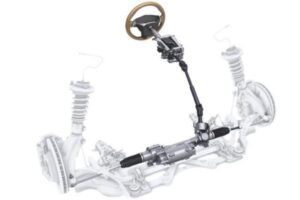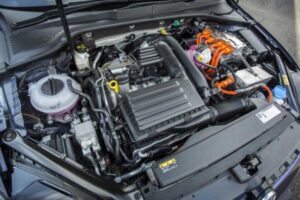The automatic transmission is a sophisticated component of modern vehicles that allows for seamless gear changes without the need for manual intervention. In this article, we will explore how the automatic transmission works, its main components, and how they interact to enable automatic gear shifting.
How Does Automatic Transmission Work?
At the heart of the automatic transmission system is a complex arrangement of gears, clutches, and fluid coupling devices. Unlike a manual transmission, where the driver has to engage and disengage gears manually using a clutch pedal, the automatic transmission takes care of this process automatically.
The key components of an automatic transmission system include:
- Torque Converter: The torque converter is a fluid coupling device that connects the engine to the transmission. It allows the engine to continue running even when the vehicle is at a standstill, enabling smooth acceleration from a stop.
- Planetary Gearset: This gearset is the central element of an automatic transmission and consists of multiple gears (sun gear, planet gears, and ring gear) that rotate around a central axis. By engaging different combinations of these gears, the transmission can achieve various gear ratios.
- Clutches and Bands: The automatic transmission uses clutches and bands to engage and disengage specific gears. The clutches are used to lock certain components of the planetary gearset, while the bands are used to hold other components stationary.
- Valve Body: The valve body is a crucial part of the automatic transmission that houses a network of valves and passages. It controls the flow of transmission fluid, directing it to the appropriate clutches and bands to engage the desired gear.
- Computer and Sensors: Modern automatic transmissions are equipped with a computer and various sensors that monitor factors such as vehicle speed, engine RPM, throttle position, and road conditions. The computer uses this data to determine the optimal gear for the current driving situation.
Advantages of Automatic Transmission
Driving a car with an automatic transmission offers several advantages, making it a popular choice for many drivers:
- Ease of Use: The primary benefit of an automatic transmission is the simplicity of operation. Drivers do not have to manually shift gears, allowing for a more straightforward and relaxed driving experience.
- Comfort: Automatic transmissions provide smooth gear changes, resulting in a more comfortable ride for both the driver and passengers.
- Reduced Driver Effort: Without the need to engage the clutch and shift gears manually, the physical effort required from the driver is significantly reduced.
- Traffic-Friendly: In stop-and-go traffic, the automatic transmission’s seamless shifting eliminates the need for constant gear changes, reducing driver fatigue.
- User-Friendly for Beginners: Automatic transmissions are ideal for novice drivers who may find manual transmissions challenging to master.
Types of Automatic Transmissions: Comparing Available Options
Automatic transmissions come in several types, each with its own set of characteristics and advantages. Let’s compare the most common types:
- Conventional Automatic Transmission: This is the traditional type of automatic transmission, utilizing a hydraulic torque converter and a planetary gearset. It offers smooth operation and is widely used in various vehicle models.
- Dual-Clutch Transmission (DCT): The DCT uses two separate clutches for even and odd gears, enabling lightning-fast gear changes. It combines the convenience of an automatic transmission with the performance of a manual transmission.
- Continuously Variable Transmission (CVT): The CVT uses a system of belts and pulleys to provide an infinite number of gear ratios, ensuring optimal engine performance and fuel efficiency.
Each type of automatic transmission has its unique characteristics, and drivers can choose the one that best suits their driving preferences and needs.
Maintaining Automatic Transmission: Tips to Prolong its Lifespan
Proper maintenance is essential to ensure the longevity and optimal performance of an automatic transmission. Here are some tips to help prolong its lifespan:
- Regular Fluid Checks: Ensure the transmission fluid is at the proper level and replace it according to the manufacturer’s recommended schedule.
- Fluid Quality: Use the correct type of transmission fluid recommended by the vehicle manufacturer to maintain smooth operation.
- Avoid Overloading: Avoid exceeding the vehicle’s maximum towing capacity, as it can put extra strain on the transmission.
- Cooling System Maintenance: Keep the engine’s cooling system in good condition to prevent overheating of the transmission.
- Gentle Driving: Avoid aggressive driving habits that can put excessive stress on the transmission, such as rapid acceleration and abrupt braking.
By following these maintenance tips, drivers can ensure their automatic transmission remains in optimal condition and delivers reliable performance.
Common Problems and Solutions of Automatic Transmissions
While automatic transmissions are generally reliable, they can experience issues over time. Some common problems include:
- Slipping Gears: Gears may slip or hesitate when shifting, which could indicate low fluid levels, worn clutches, or other internal issues.
- Delayed Engagement: A delay in gear engagement could be caused by fluid problems, faulty sensors, or worn bands.
- Transmission Leaks: Leaks can occur due to damaged seals or gaskets, leading to low fluid levels and potential transmission damage.
- Check Engine Light: The check engine light may illuminate due to various transmission-related issues, requiring a diagnostic check by a qualified mechanic.
If drivers encounter any of these problems, it’s essential to address them promptly to prevent further damage and costly repairs. Consulting a professional mechanic is advisable to diagnose and resolve any transmission issues.
Technology and Innovation in Automatic Transmissions: The Future of Mobility
As automotive technology evolves, so do automatic transmissions. Advancements in materials, electronics, and software have paved the way for innovative transmission systems. Here are some trends and innovations shaping the future of automatic transmissions:
- Electrification: As electric vehicles become more prevalent, we see the rise of electric powertrains that do not require traditional automatic transmissions. Instead, electric vehicles use a single-speed transmission or direct-drive systems.
- Hybrid Transmissions: Hybrid vehicles combine an internal combustion engine with an electric motor. Innovative hybrid transmissions optimize power delivery and efficiency by blending power from both sources seamlessly.
- Advanced Control Systems: State-of-the-art control systems, using artificial intelligence and machine learning algorithms, optimize gear selection based on real-time data, driving habits, and road conditions.
- Automated Manual Transmissions: Automated manual transmissions offer the convenience of an automatic transmission while retaining the mechanical efficiency of a manual gearbox.
- Integration with Driver Assistance Systems: Automatic transmissions are becoming more integrated with driver assistance systems, allowing for predictive gear shifts based on GPS data, road conditions, and traffic patterns.
Driving a Car with Automatic Transmission: Tips for Proper Adaptation
For drivers transitioning from a manual to an automatic transmission, here are some essential tips to adapt to the new driving experience:
- Familiarize with Gear Positions: Get acquainted with the different gear positions (P – Park, R – Reverse, N – Neutral, D – Drive, etc.) and their respective functions.
- Brake Application: Always engage the brake pedal before shifting out of Park or into Drive to prevent unintended movement.
- Avoid Resting Foot on Pedals: Resist the habit of resting your foot on the brake or gas pedal while driving, as it can lead to unnecessary braking or acceleration.
- Use Overdrive: Utilize the Overdrive (OD) function for highway driving to reduce engine RPM and improve fuel efficiency.
- Be Mindful of Downshifts: When descending steep hills, manually selecting lower gears (if available) can help control speed and reduce brake wear.
Conclusion
The automatic transmission has revolutionized the driving experience, offering convenience, comfort, and efficiency to millions of drivers worldwide. Understanding how automatic transmissions work and their various advantages can help drivers make informed choices when selecting a vehicle.
With advancements in technology and innovation, automatic transmissions continue to evolve, integrating with electrification and driver assistance systems to shape the future of mobility. Regular maintenance and proper driving habits are essential to prolonging the lifespan and ensuring optimal performance of an automatic transmission.
Whether you are a seasoned driver or a beginner, adapting to a car with automatic transmission is straightforward with a little familiarity and practice. As technology continues to push the boundaries of automotive engineering, the automatic transmission remains a cornerstone of modern transportation, facilitating effortless and enjoyable driving experiences for all.



